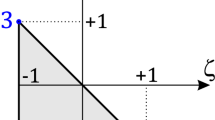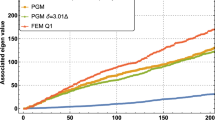Abstract
Compared to other fields of engineering, in mechanical engineering, the Discrete Element Method (DEM) is not yet a well known method. Nevertheless, there is a variety of simulation problems where the method has obvious advantages due to its meshless nature. For problems where several free bodies can collide and break after having been largely deformed, the DEM is the method of choice. Neighborhood search and collision detection between bodies as well as the separation of large solids into smaller particles are naturally incorporated in the method. The main DEM algorithm consists of a relatively simple loop that basically contains the three substeps contact detection, force computation and integration. However, there exists a large variety of different algorithms to choose the substeps to compose the optimal method for a given problem. In this contribution, we describe the dynamics of particle systems together with appropriate numerical integration schemes and give an overview over different types of particle interactions that can be composed to adapt the method to fit to a given simulation problem. Surface triangulations are used to model complicated, non-convex bodies in contact with particle systems. The capabilities of the method are finally demonstrated by means of application examples.
Similar content being viewed by others
References
Cundall, P.A.: A computer model for simulation of progressive, large-scale movements in blocky rock systems. In: Proceedings of the Symposium of the International Society of Rock Mechanics, Nancy (1971)
Cundall, P.A., Strack, O.D.L.: A discrete numerical model for granular assemblies. Geotechnique 29, 47–56 (1979)
Shabana, A.A.: Computational Dynamics. Wiley, New York (2001)
Omelyan, I.P.: On the numerical integration of motion for rigid polyatomics: the modified quaternion approach. Comput. Phys. 12(1), 97–103 (1998)
Roberson, R.E., Schwertassek, R.: Dynamics of Multibody Systems. Springer, Berlin (1988)
Hairer, E., Wanner, G.: Stiff differential equations solved by Radau methods. J. Comput. Appl. Math. 111, 93–111 (1999)
Hairer, E., Wanner, G.: Solving Ordinary Differential Equations. II: Stiff and Differential-Algebraic Problems. Springer, Berlin (1991)
Petzold, L.R.: A description of DASSL: a differential/algebraic system solver. In: Stepleman, R. (ed.) Scientific Computing: Application of Mathematics and Computing to the Physical Sciences, vol. 2, pp. 65–68 (1983)
Verlet, L.: Computer experiments on classical fluids. Phys. Rev. 159, 98–103 (1967)
Allen, M.P., Tildesley, D.J.: Computer Simulations of Liquids. Clarendon, Oxford (1989)
Geradin, M., Rixon, D.: Mechanical Vibrations. Theory and Application to Structural Dynamics. Wiley, Chichester (1997)
Zohdi, T.I.: Charge-induced clustering in multifield particulate flows. Int. J. Numer. Methods Eng. 62, 870–898 (2004)
Lankarani, H.M., Nikravesh, P.E.: A contact force model with hysteresis damping for impact analysis of multibody systems. J. Mech. Des. 112, 369–376 (1990)
Muth, B., Eberhard, P.: Collisions between particles of complex shape. In: Garcia-Rojo, R., Herrmann, H.J., McNamara, S. (eds.) Powders and Grains, pp. 1379–1383 (2005)
Muth, B., Eberhard, P.: Investigation of large systems consisting of many spatial polyhedral bodies. In: van Campen, D.H., Lzurko, M.D., van den Oever, W.P.J.M. (eds.) Proceedings of the ENOC-2005, Fifth EUROMECH Nonlinear Dynamics Conference, pp. 1644–1650 (2005)
Brendel, L., Dippel, S.: Lasting Contacts in Molecular Dynamics Simulations, p. 313ff. Kluwer Academic, Dordrecht (1998)
Herrmann, H., D’Adetta, G.A., Kun, F., Ramm, E.: Two-dimensional dynamic simulation of fracture and fragmentation of solids. Comput. Assis. Mech. Eng. Sci. 6, 385–402 (1999)
Potapov, A.V., Hopkins, M.A., Campbell, C.S.: A two-dimensional dynamic simulation of solid fracture. Int. J. Mod. Phys. C 6(3), 371–398 (1995)
D’Addetta, G.A., Ramm, E.: A microstructure-based simulation environment on the basis of an interface enhanced particle model. Granul. Matter 8, 159–174 (2006)
Liu, K., Gao, L., Tanimura, S.: Application of discrete element method in impact problems. JSME Int. J. Ser. A 47(2), 138–145 (2004)
Courant, R., Friedrichs, K., Lewy, H.: On the partial difference equations of mathematical physics. IBM J. 11, 215–234 (1967)
Author information
Authors and Affiliations
Corresponding author
Additional information
Commemorative Contribution.
Rights and permissions
About this article
Cite this article
Fleissner, F., Gaugele, T. & Eberhard, P. Applications of the discrete element method in mechanical engineering. Multibody Syst Dyn 18, 81–94 (2007). https://doi.org/10.1007/s11044-007-9066-2
Received:
Accepted:
Published:
Issue Date:
DOI: https://doi.org/10.1007/s11044-007-9066-2




